BM7024 - KDS Qualitative Data Analysis: Market Research Report
VerifiedAdded on 2023/06/18
|15
|3295
|114
Report
AI Summary
This report presents a qualitative data analysis of Kingston Department Store (KDS), focusing on understanding customer behavior and improving store patronage. The analysis employs open coding, axial coding, and selective coding techniques to interpret interview data from female customers. Open coding identifies initial themes such as shopping frequency, reasons for visiting, and product preferences. Axial coding then categorizes these themes into broader concepts like 'Frequency of Visit' and 'Reasons for Visiting the Store.' The analysis reveals that customers primarily visit KDS for its quality products and convenient price range. The report concludes by discussing the implications of these findings for KDS's strategic planning and customer engagement initiatives. Desklib provides access to this and many other solved assignments for students.

DATA ANALYSIS –
QUALITATIVE
QUALITATIVE
Paraphrase This Document
Need a fresh take? Get an instant paraphrase of this document with our AI Paraphraser
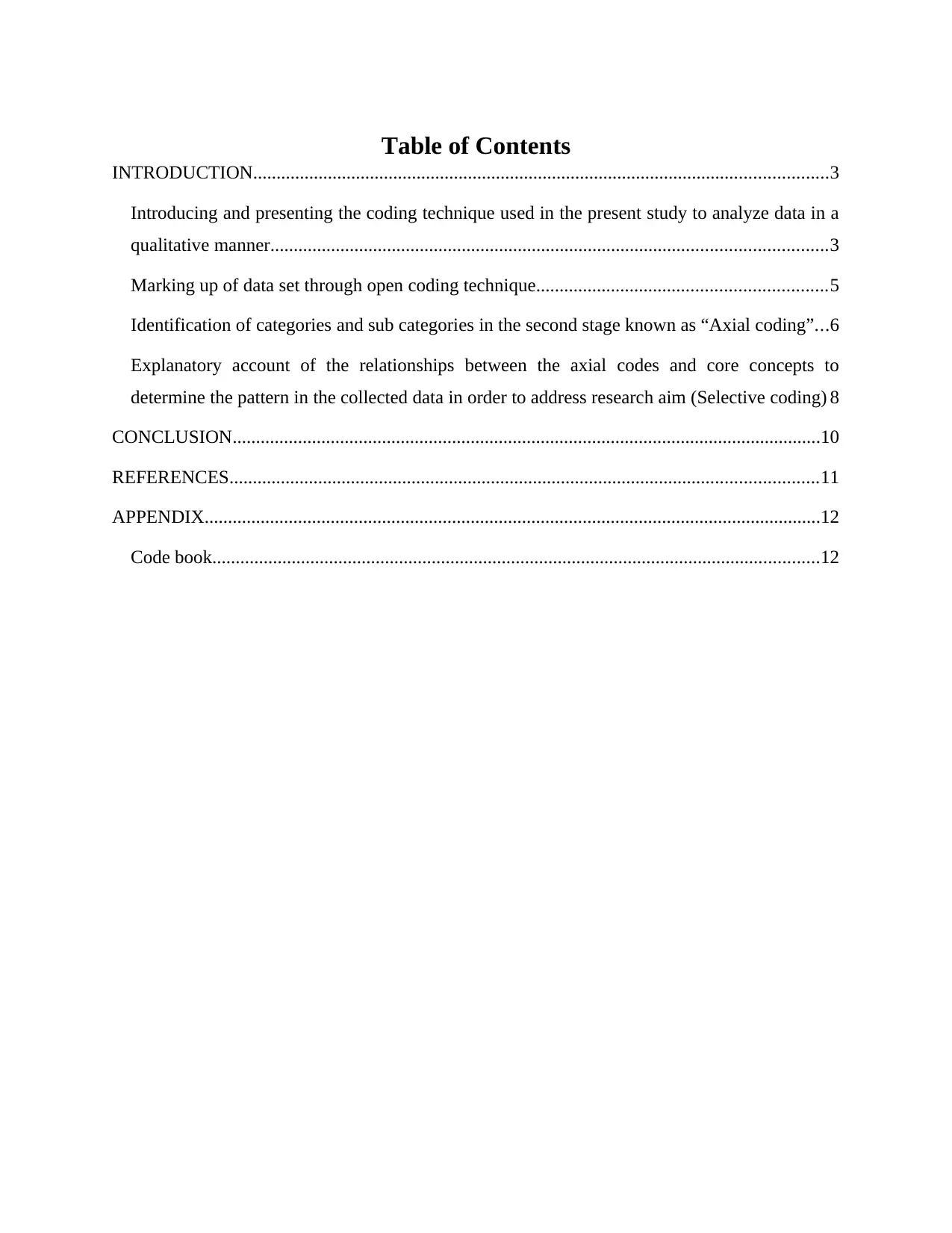
Table of Contents
INTRODUCTION...........................................................................................................................3
Introducing and presenting the coding technique used in the present study to analyze data in a
qualitative manner.......................................................................................................................3
Marking up of data set through open coding technique..............................................................5
Identification of categories and sub categories in the second stage known as “Axial coding”...6
Explanatory account of the relationships between the axial codes and core concepts to
determine the pattern in the collected data in order to address research aim (Selective coding) 8
CONCLUSION..............................................................................................................................10
REFERENCES..............................................................................................................................11
APPENDIX....................................................................................................................................12
Code book..................................................................................................................................12
INTRODUCTION...........................................................................................................................3
Introducing and presenting the coding technique used in the present study to analyze data in a
qualitative manner.......................................................................................................................3
Marking up of data set through open coding technique..............................................................5
Identification of categories and sub categories in the second stage known as “Axial coding”...6
Explanatory account of the relationships between the axial codes and core concepts to
determine the pattern in the collected data in order to address research aim (Selective coding) 8
CONCLUSION..............................................................................................................................10
REFERENCES..............................................................................................................................11
APPENDIX....................................................................................................................................12
Code book..................................................................................................................................12
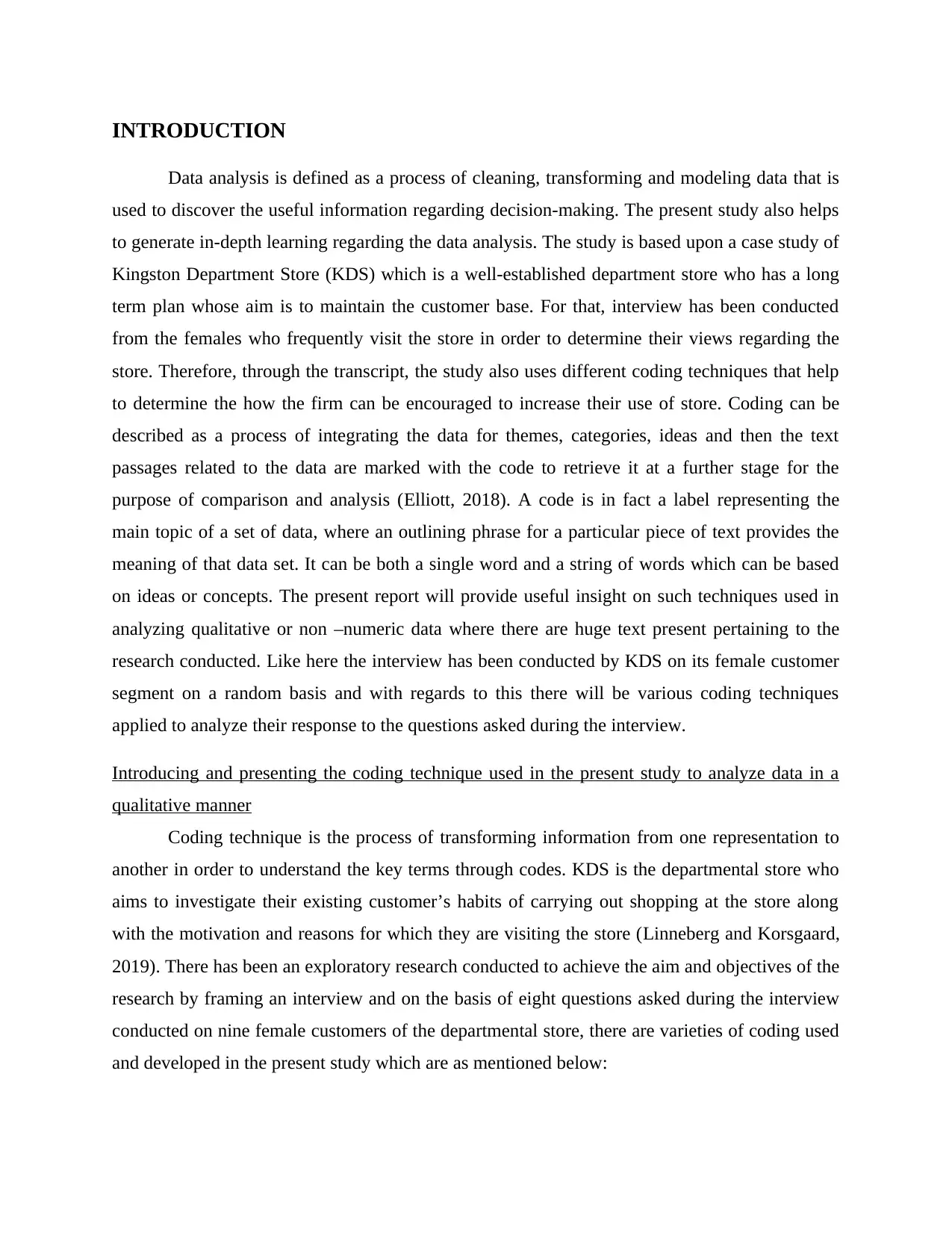
INTRODUCTION
Data analysis is defined as a process of cleaning, transforming and modeling data that is
used to discover the useful information regarding decision-making. The present study also helps
to generate in-depth learning regarding the data analysis. The study is based upon a case study of
Kingston Department Store (KDS) which is a well-established department store who has a long
term plan whose aim is to maintain the customer base. For that, interview has been conducted
from the females who frequently visit the store in order to determine their views regarding the
store. Therefore, through the transcript, the study also uses different coding techniques that help
to determine the how the firm can be encouraged to increase their use of store. Coding can be
described as a process of integrating the data for themes, categories, ideas and then the text
passages related to the data are marked with the code to retrieve it at a further stage for the
purpose of comparison and analysis (Elliott, 2018). A code is in fact a label representing the
main topic of a set of data, where an outlining phrase for a particular piece of text provides the
meaning of that data set. It can be both a single word and a string of words which can be based
on ideas or concepts. The present report will provide useful insight on such techniques used in
analyzing qualitative or non –numeric data where there are huge text present pertaining to the
research conducted. Like here the interview has been conducted by KDS on its female customer
segment on a random basis and with regards to this there will be various coding techniques
applied to analyze their response to the questions asked during the interview.
Introducing and presenting the coding technique used in the present study to analyze data in a
qualitative manner
Coding technique is the process of transforming information from one representation to
another in order to understand the key terms through codes. KDS is the departmental store who
aims to investigate their existing customer’s habits of carrying out shopping at the store along
with the motivation and reasons for which they are visiting the store (Linneberg and Korsgaard,
2019). There has been an exploratory research conducted to achieve the aim and objectives of the
research by framing an interview and on the basis of eight questions asked during the interview
conducted on nine female customers of the departmental store, there are varieties of coding used
and developed in the present study which are as mentioned below:
Data analysis is defined as a process of cleaning, transforming and modeling data that is
used to discover the useful information regarding decision-making. The present study also helps
to generate in-depth learning regarding the data analysis. The study is based upon a case study of
Kingston Department Store (KDS) which is a well-established department store who has a long
term plan whose aim is to maintain the customer base. For that, interview has been conducted
from the females who frequently visit the store in order to determine their views regarding the
store. Therefore, through the transcript, the study also uses different coding techniques that help
to determine the how the firm can be encouraged to increase their use of store. Coding can be
described as a process of integrating the data for themes, categories, ideas and then the text
passages related to the data are marked with the code to retrieve it at a further stage for the
purpose of comparison and analysis (Elliott, 2018). A code is in fact a label representing the
main topic of a set of data, where an outlining phrase for a particular piece of text provides the
meaning of that data set. It can be both a single word and a string of words which can be based
on ideas or concepts. The present report will provide useful insight on such techniques used in
analyzing qualitative or non –numeric data where there are huge text present pertaining to the
research conducted. Like here the interview has been conducted by KDS on its female customer
segment on a random basis and with regards to this there will be various coding techniques
applied to analyze their response to the questions asked during the interview.
Introducing and presenting the coding technique used in the present study to analyze data in a
qualitative manner
Coding technique is the process of transforming information from one representation to
another in order to understand the key terms through codes. KDS is the departmental store who
aims to investigate their existing customer’s habits of carrying out shopping at the store along
with the motivation and reasons for which they are visiting the store (Linneberg and Korsgaard,
2019). There has been an exploratory research conducted to achieve the aim and objectives of the
research by framing an interview and on the basis of eight questions asked during the interview
conducted on nine female customers of the departmental store, there are varieties of coding used
and developed in the present study which are as mentioned below:
⊘ This is a preview!⊘
Do you want full access?
Subscribe today to unlock all pages.

Trusted by 1+ million students worldwide
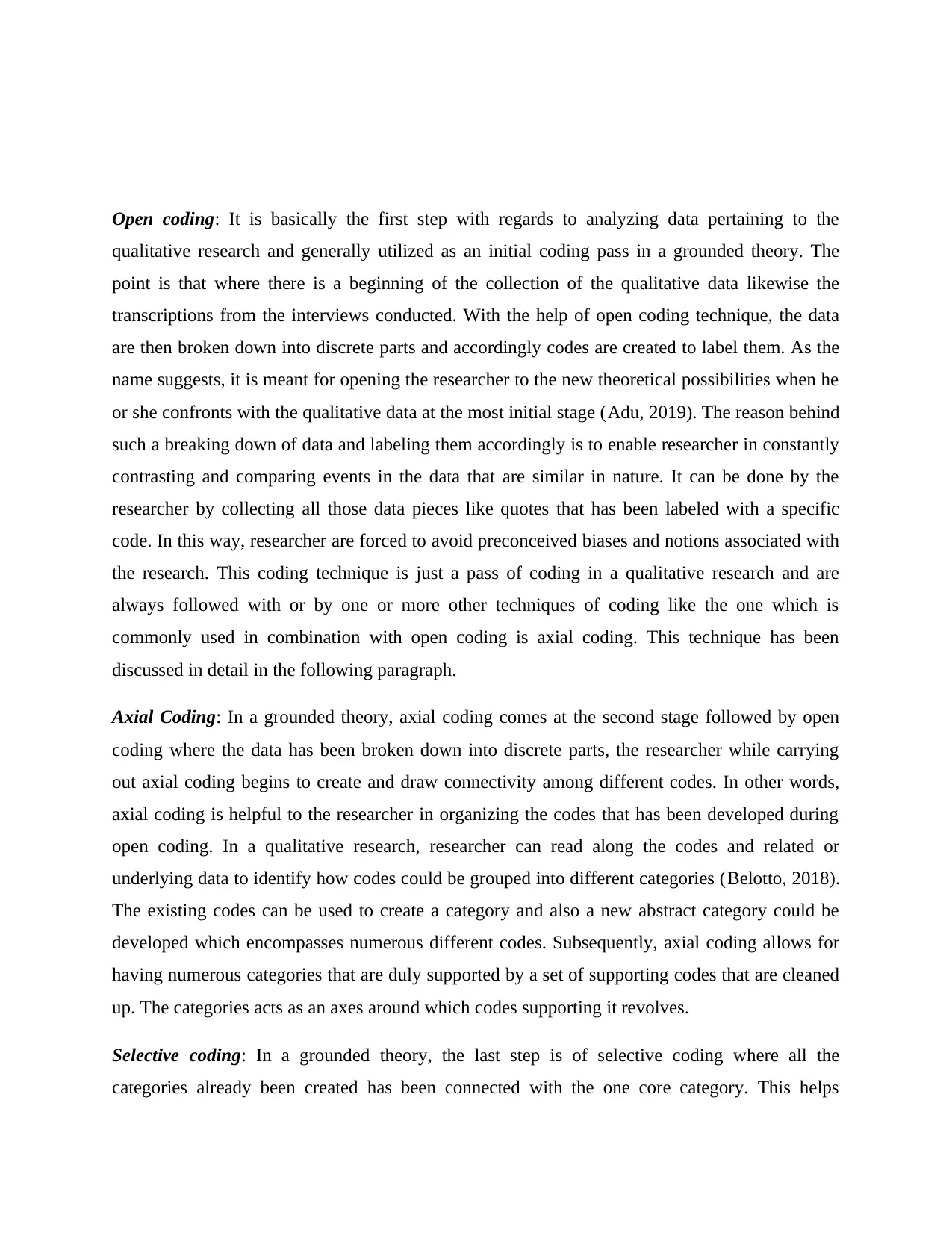
Open coding: It is basically the first step with regards to analyzing data pertaining to the
qualitative research and generally utilized as an initial coding pass in a grounded theory. The
point is that where there is a beginning of the collection of the qualitative data likewise the
transcriptions from the interviews conducted. With the help of open coding technique, the data
are then broken down into discrete parts and accordingly codes are created to label them. As the
name suggests, it is meant for opening the researcher to the new theoretical possibilities when he
or she confronts with the qualitative data at the most initial stage (Adu, 2019). The reason behind
such a breaking down of data and labeling them accordingly is to enable researcher in constantly
contrasting and comparing events in the data that are similar in nature. It can be done by the
researcher by collecting all those data pieces like quotes that has been labeled with a specific
code. In this way, researcher are forced to avoid preconceived biases and notions associated with
the research. This coding technique is just a pass of coding in a qualitative research and are
always followed with or by one or more other techniques of coding like the one which is
commonly used in combination with open coding is axial coding. This technique has been
discussed in detail in the following paragraph.
Axial Coding: In a grounded theory, axial coding comes at the second stage followed by open
coding where the data has been broken down into discrete parts, the researcher while carrying
out axial coding begins to create and draw connectivity among different codes. In other words,
axial coding is helpful to the researcher in organizing the codes that has been developed during
open coding. In a qualitative research, researcher can read along the codes and related or
underlying data to identify how codes could be grouped into different categories (Belotto, 2018).
The existing codes can be used to create a category and also a new abstract category could be
developed which encompasses numerous different codes. Subsequently, axial coding allows for
having numerous categories that are duly supported by a set of supporting codes that are cleaned
up. The categories acts as an axes around which codes supporting it revolves.
Selective coding: In a grounded theory, the last step is of selective coding where all the
categories already been created has been connected with the one core category. This helps
qualitative research and generally utilized as an initial coding pass in a grounded theory. The
point is that where there is a beginning of the collection of the qualitative data likewise the
transcriptions from the interviews conducted. With the help of open coding technique, the data
are then broken down into discrete parts and accordingly codes are created to label them. As the
name suggests, it is meant for opening the researcher to the new theoretical possibilities when he
or she confronts with the qualitative data at the most initial stage (Adu, 2019). The reason behind
such a breaking down of data and labeling them accordingly is to enable researcher in constantly
contrasting and comparing events in the data that are similar in nature. It can be done by the
researcher by collecting all those data pieces like quotes that has been labeled with a specific
code. In this way, researcher are forced to avoid preconceived biases and notions associated with
the research. This coding technique is just a pass of coding in a qualitative research and are
always followed with or by one or more other techniques of coding like the one which is
commonly used in combination with open coding is axial coding. This technique has been
discussed in detail in the following paragraph.
Axial Coding: In a grounded theory, axial coding comes at the second stage followed by open
coding where the data has been broken down into discrete parts, the researcher while carrying
out axial coding begins to create and draw connectivity among different codes. In other words,
axial coding is helpful to the researcher in organizing the codes that has been developed during
open coding. In a qualitative research, researcher can read along the codes and related or
underlying data to identify how codes could be grouped into different categories (Belotto, 2018).
The existing codes can be used to create a category and also a new abstract category could be
developed which encompasses numerous different codes. Subsequently, axial coding allows for
having numerous categories that are duly supported by a set of supporting codes that are cleaned
up. The categories acts as an axes around which codes supporting it revolves.
Selective coding: In a grounded theory, the last step is of selective coding where all the
categories already been created has been connected with the one core category. This helps
Paraphrase This Document
Need a fresh take? Get an instant paraphrase of this document with our AI Paraphraser
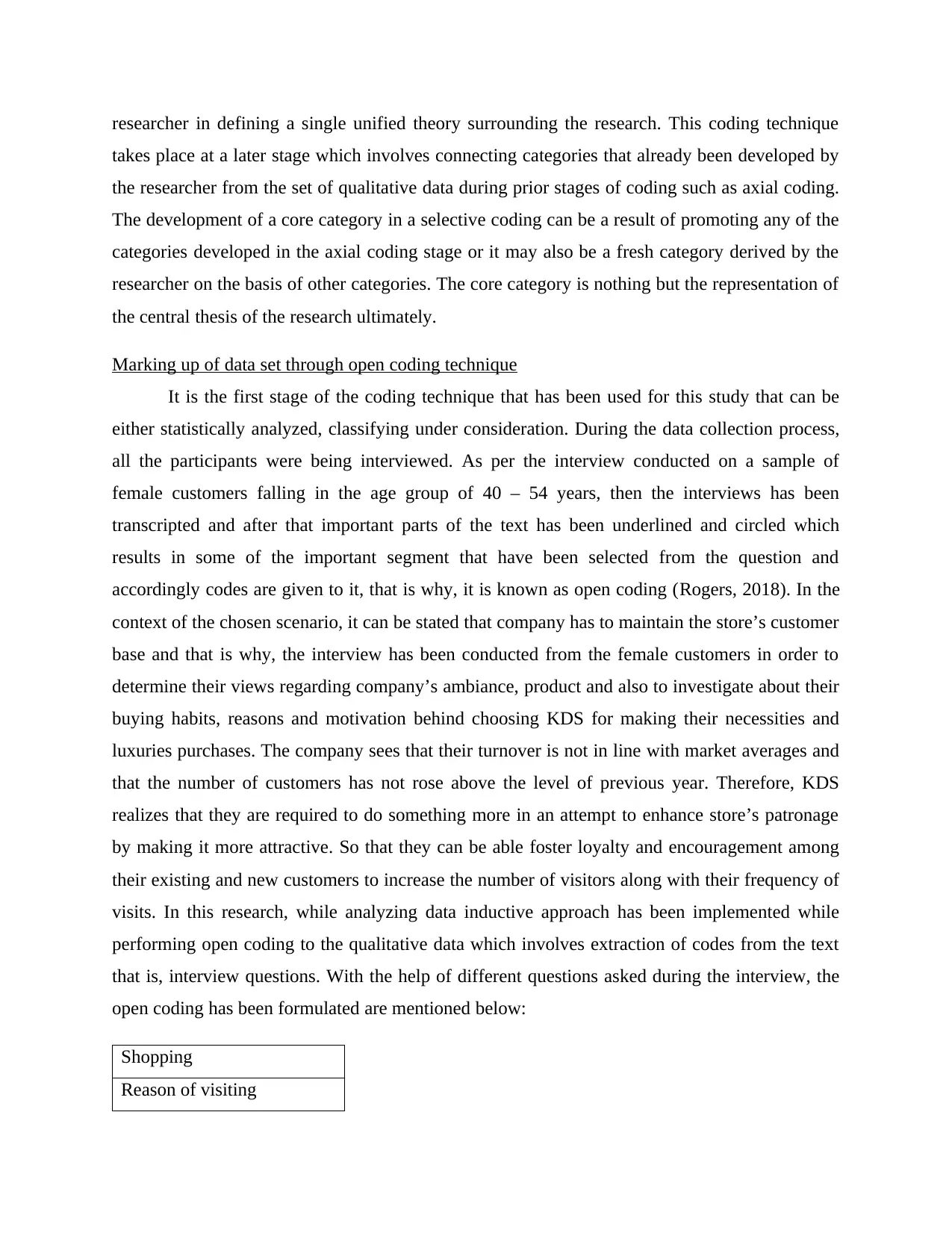
researcher in defining a single unified theory surrounding the research. This coding technique
takes place at a later stage which involves connecting categories that already been developed by
the researcher from the set of qualitative data during prior stages of coding such as axial coding.
The development of a core category in a selective coding can be a result of promoting any of the
categories developed in the axial coding stage or it may also be a fresh category derived by the
researcher on the basis of other categories. The core category is nothing but the representation of
the central thesis of the research ultimately.
Marking up of data set through open coding technique
It is the first stage of the coding technique that has been used for this study that can be
either statistically analyzed, classifying under consideration. During the data collection process,
all the participants were being interviewed. As per the interview conducted on a sample of
female customers falling in the age group of 40 – 54 years, then the interviews has been
transcripted and after that important parts of the text has been underlined and circled which
results in some of the important segment that have been selected from the question and
accordingly codes are given to it, that is why, it is known as open coding (Rogers, 2018). In the
context of the chosen scenario, it can be stated that company has to maintain the store’s customer
base and that is why, the interview has been conducted from the female customers in order to
determine their views regarding company’s ambiance, product and also to investigate about their
buying habits, reasons and motivation behind choosing KDS for making their necessities and
luxuries purchases. The company sees that their turnover is not in line with market averages and
that the number of customers has not rose above the level of previous year. Therefore, KDS
realizes that they are required to do something more in an attempt to enhance store’s patronage
by making it more attractive. So that they can be able foster loyalty and encouragement among
their existing and new customers to increase the number of visitors along with their frequency of
visits. In this research, while analyzing data inductive approach has been implemented while
performing open coding to the qualitative data which involves extraction of codes from the text
that is, interview questions. With the help of different questions asked during the interview, the
open coding has been formulated are mentioned below:
Shopping
Reason of visiting
takes place at a later stage which involves connecting categories that already been developed by
the researcher from the set of qualitative data during prior stages of coding such as axial coding.
The development of a core category in a selective coding can be a result of promoting any of the
categories developed in the axial coding stage or it may also be a fresh category derived by the
researcher on the basis of other categories. The core category is nothing but the representation of
the central thesis of the research ultimately.
Marking up of data set through open coding technique
It is the first stage of the coding technique that has been used for this study that can be
either statistically analyzed, classifying under consideration. During the data collection process,
all the participants were being interviewed. As per the interview conducted on a sample of
female customers falling in the age group of 40 – 54 years, then the interviews has been
transcripted and after that important parts of the text has been underlined and circled which
results in some of the important segment that have been selected from the question and
accordingly codes are given to it, that is why, it is known as open coding (Rogers, 2018). In the
context of the chosen scenario, it can be stated that company has to maintain the store’s customer
base and that is why, the interview has been conducted from the female customers in order to
determine their views regarding company’s ambiance, product and also to investigate about their
buying habits, reasons and motivation behind choosing KDS for making their necessities and
luxuries purchases. The company sees that their turnover is not in line with market averages and
that the number of customers has not rose above the level of previous year. Therefore, KDS
realizes that they are required to do something more in an attempt to enhance store’s patronage
by making it more attractive. So that they can be able foster loyalty and encouragement among
their existing and new customers to increase the number of visitors along with their frequency of
visits. In this research, while analyzing data inductive approach has been implemented while
performing open coding to the qualitative data which involves extraction of codes from the text
that is, interview questions. With the help of different questions asked during the interview, the
open coding has been formulated are mentioned below:
Shopping
Reason of visiting
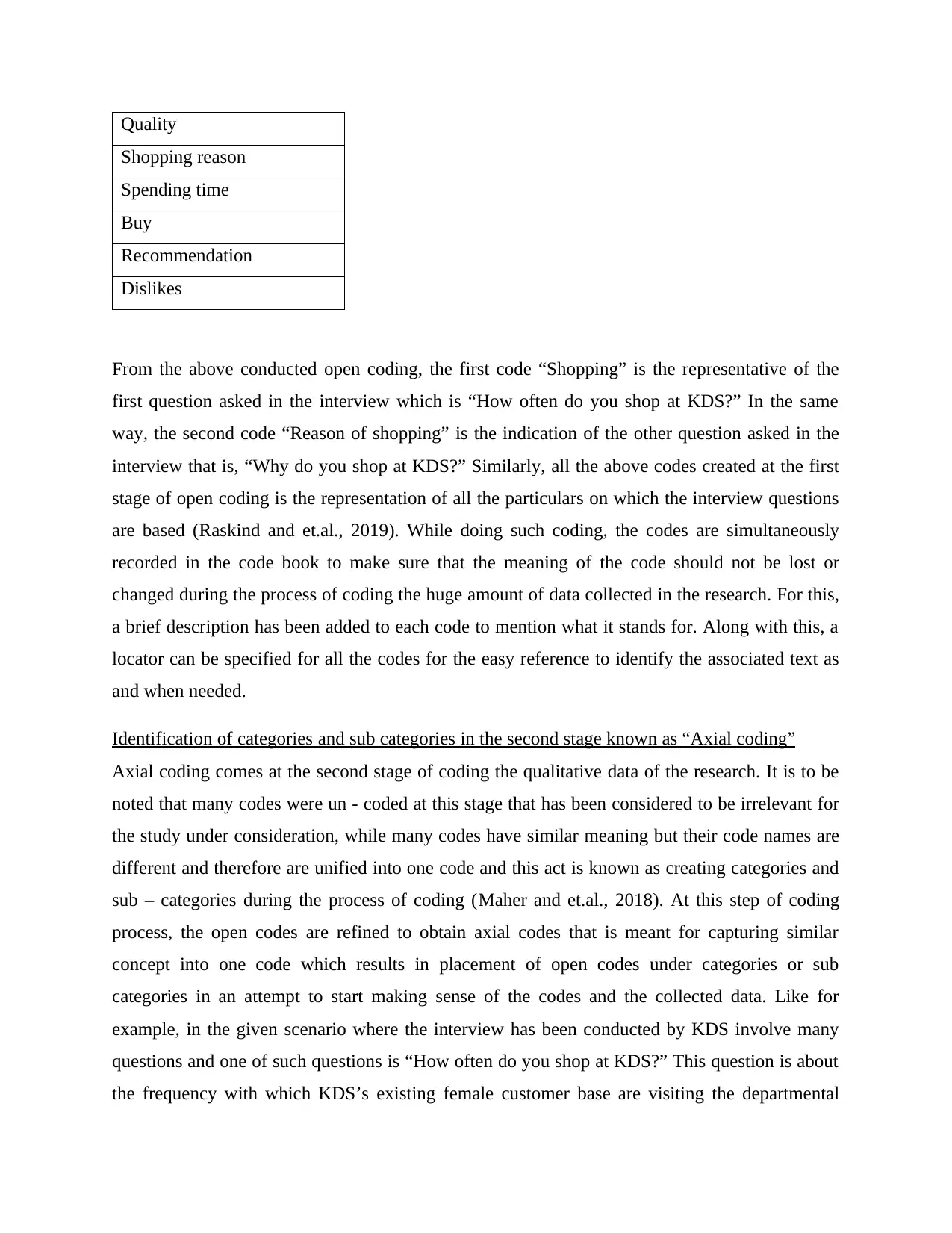
Quality
Shopping reason
Spending time
Buy
Recommendation
Dislikes
From the above conducted open coding, the first code “Shopping” is the representative of the
first question asked in the interview which is “How often do you shop at KDS?” In the same
way, the second code “Reason of shopping” is the indication of the other question asked in the
interview that is, “Why do you shop at KDS?” Similarly, all the above codes created at the first
stage of open coding is the representation of all the particulars on which the interview questions
are based (Raskind and et.al., 2019). While doing such coding, the codes are simultaneously
recorded in the code book to make sure that the meaning of the code should not be lost or
changed during the process of coding the huge amount of data collected in the research. For this,
a brief description has been added to each code to mention what it stands for. Along with this, a
locator can be specified for all the codes for the easy reference to identify the associated text as
and when needed.
Identification of categories and sub categories in the second stage known as “Axial coding”
Axial coding comes at the second stage of coding the qualitative data of the research. It is to be
noted that many codes were un - coded at this stage that has been considered to be irrelevant for
the study under consideration, while many codes have similar meaning but their code names are
different and therefore are unified into one code and this act is known as creating categories and
sub – categories during the process of coding (Maher and et.al., 2018). At this step of coding
process, the open codes are refined to obtain axial codes that is meant for capturing similar
concept into one code which results in placement of open codes under categories or sub
categories in an attempt to start making sense of the codes and the collected data. Like for
example, in the given scenario where the interview has been conducted by KDS involve many
questions and one of such questions is “How often do you shop at KDS?” This question is about
the frequency with which KDS’s existing female customer base are visiting the departmental
Shopping reason
Spending time
Buy
Recommendation
Dislikes
From the above conducted open coding, the first code “Shopping” is the representative of the
first question asked in the interview which is “How often do you shop at KDS?” In the same
way, the second code “Reason of shopping” is the indication of the other question asked in the
interview that is, “Why do you shop at KDS?” Similarly, all the above codes created at the first
stage of open coding is the representation of all the particulars on which the interview questions
are based (Raskind and et.al., 2019). While doing such coding, the codes are simultaneously
recorded in the code book to make sure that the meaning of the code should not be lost or
changed during the process of coding the huge amount of data collected in the research. For this,
a brief description has been added to each code to mention what it stands for. Along with this, a
locator can be specified for all the codes for the easy reference to identify the associated text as
and when needed.
Identification of categories and sub categories in the second stage known as “Axial coding”
Axial coding comes at the second stage of coding the qualitative data of the research. It is to be
noted that many codes were un - coded at this stage that has been considered to be irrelevant for
the study under consideration, while many codes have similar meaning but their code names are
different and therefore are unified into one code and this act is known as creating categories and
sub – categories during the process of coding (Maher and et.al., 2018). At this step of coding
process, the open codes are refined to obtain axial codes that is meant for capturing similar
concept into one code which results in placement of open codes under categories or sub
categories in an attempt to start making sense of the codes and the collected data. Like for
example, in the given scenario where the interview has been conducted by KDS involve many
questions and one of such questions is “How often do you shop at KDS?” This question is about
the frequency with which KDS’s existing female customer base are visiting the departmental
⊘ This is a preview!⊘
Do you want full access?
Subscribe today to unlock all pages.

Trusted by 1+ million students worldwide
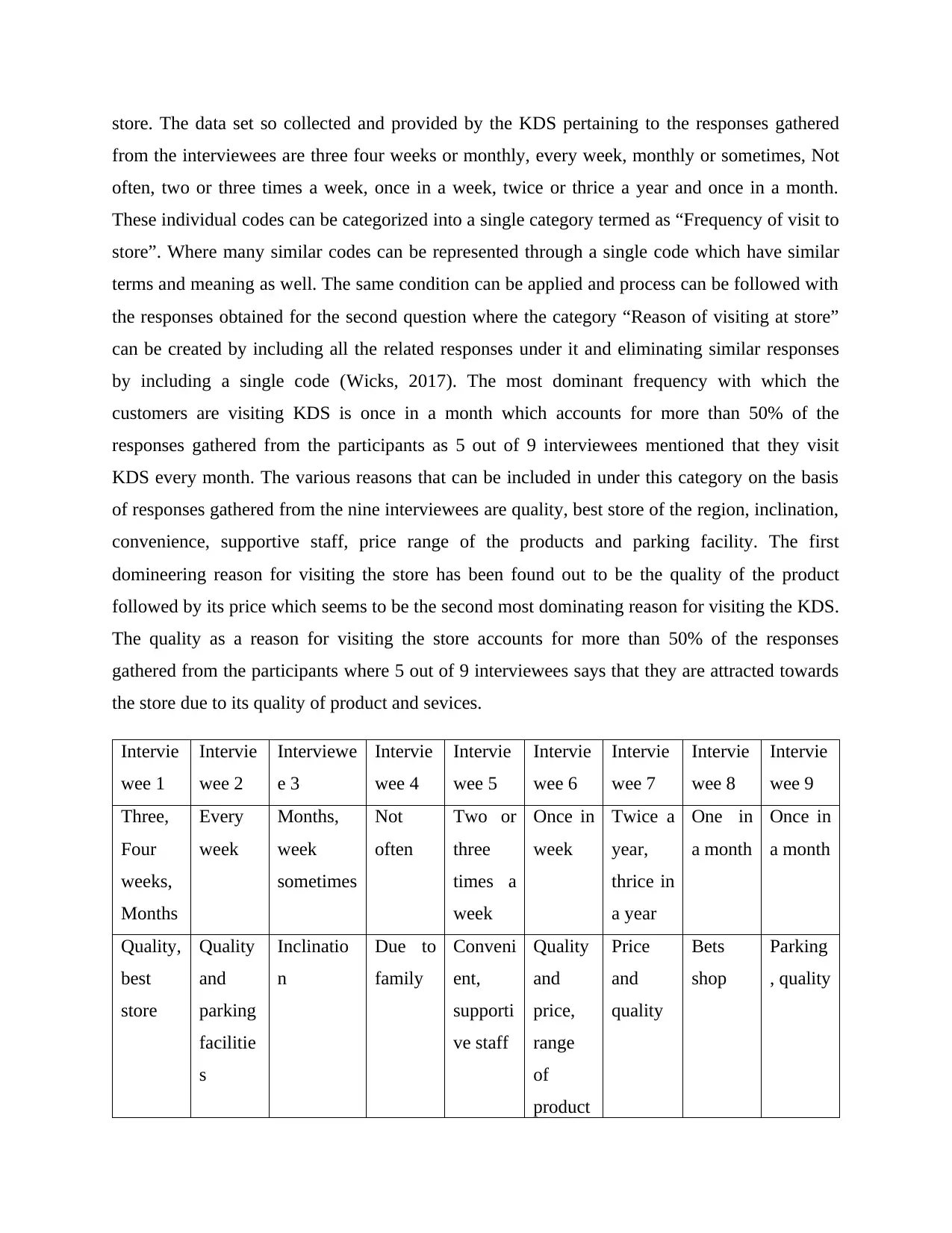
store. The data set so collected and provided by the KDS pertaining to the responses gathered
from the interviewees are three four weeks or monthly, every week, monthly or sometimes, Not
often, two or three times a week, once in a week, twice or thrice a year and once in a month.
These individual codes can be categorized into a single category termed as “Frequency of visit to
store”. Where many similar codes can be represented through a single code which have similar
terms and meaning as well. The same condition can be applied and process can be followed with
the responses obtained for the second question where the category “Reason of visiting at store”
can be created by including all the related responses under it and eliminating similar responses
by including a single code (Wicks, 2017). The most dominant frequency with which the
customers are visiting KDS is once in a month which accounts for more than 50% of the
responses gathered from the participants as 5 out of 9 interviewees mentioned that they visit
KDS every month. The various reasons that can be included in under this category on the basis
of responses gathered from the nine interviewees are quality, best store of the region, inclination,
convenience, supportive staff, price range of the products and parking facility. The first
domineering reason for visiting the store has been found out to be the quality of the product
followed by its price which seems to be the second most dominating reason for visiting the KDS.
The quality as a reason for visiting the store accounts for more than 50% of the responses
gathered from the participants where 5 out of 9 interviewees says that they are attracted towards
the store due to its quality of product and sevices.
Intervie
wee 1
Intervie
wee 2
Interviewe
e 3
Intervie
wee 4
Intervie
wee 5
Intervie
wee 6
Intervie
wee 7
Intervie
wee 8
Intervie
wee 9
Three,
Four
weeks,
Months
Every
week
Months,
week
sometimes
Not
often
Two or
three
times a
week
Once in
week
Twice a
year,
thrice in
a year
One in
a month
Once in
a month
Quality,
best
store
Quality
and
parking
facilitie
s
Inclinatio
n
Due to
family
Conveni
ent,
supporti
ve staff
Quality
and
price,
range
of
product
Price
and
quality
Bets
shop
Parking
, quality
from the interviewees are three four weeks or monthly, every week, monthly or sometimes, Not
often, two or three times a week, once in a week, twice or thrice a year and once in a month.
These individual codes can be categorized into a single category termed as “Frequency of visit to
store”. Where many similar codes can be represented through a single code which have similar
terms and meaning as well. The same condition can be applied and process can be followed with
the responses obtained for the second question where the category “Reason of visiting at store”
can be created by including all the related responses under it and eliminating similar responses
by including a single code (Wicks, 2017). The most dominant frequency with which the
customers are visiting KDS is once in a month which accounts for more than 50% of the
responses gathered from the participants as 5 out of 9 interviewees mentioned that they visit
KDS every month. The various reasons that can be included in under this category on the basis
of responses gathered from the nine interviewees are quality, best store of the region, inclination,
convenience, supportive staff, price range of the products and parking facility. The first
domineering reason for visiting the store has been found out to be the quality of the product
followed by its price which seems to be the second most dominating reason for visiting the KDS.
The quality as a reason for visiting the store accounts for more than 50% of the responses
gathered from the participants where 5 out of 9 interviewees says that they are attracted towards
the store due to its quality of product and sevices.
Intervie
wee 1
Intervie
wee 2
Interviewe
e 3
Intervie
wee 4
Intervie
wee 5
Intervie
wee 6
Intervie
wee 7
Intervie
wee 8
Intervie
wee 9
Three,
Four
weeks,
Months
Every
week
Months,
week
sometimes
Not
often
Two or
three
times a
week
Once in
week
Twice a
year,
thrice in
a year
One in
a month
Once in
a month
Quality,
best
store
Quality
and
parking
facilitie
s
Inclinatio
n
Due to
family
Conveni
ent,
supporti
ve staff
Quality
and
price,
range
of
product
Price
and
quality
Bets
shop
Parking
, quality
Paraphrase This Document
Need a fresh take? Get an instant paraphrase of this document with our AI Paraphraser
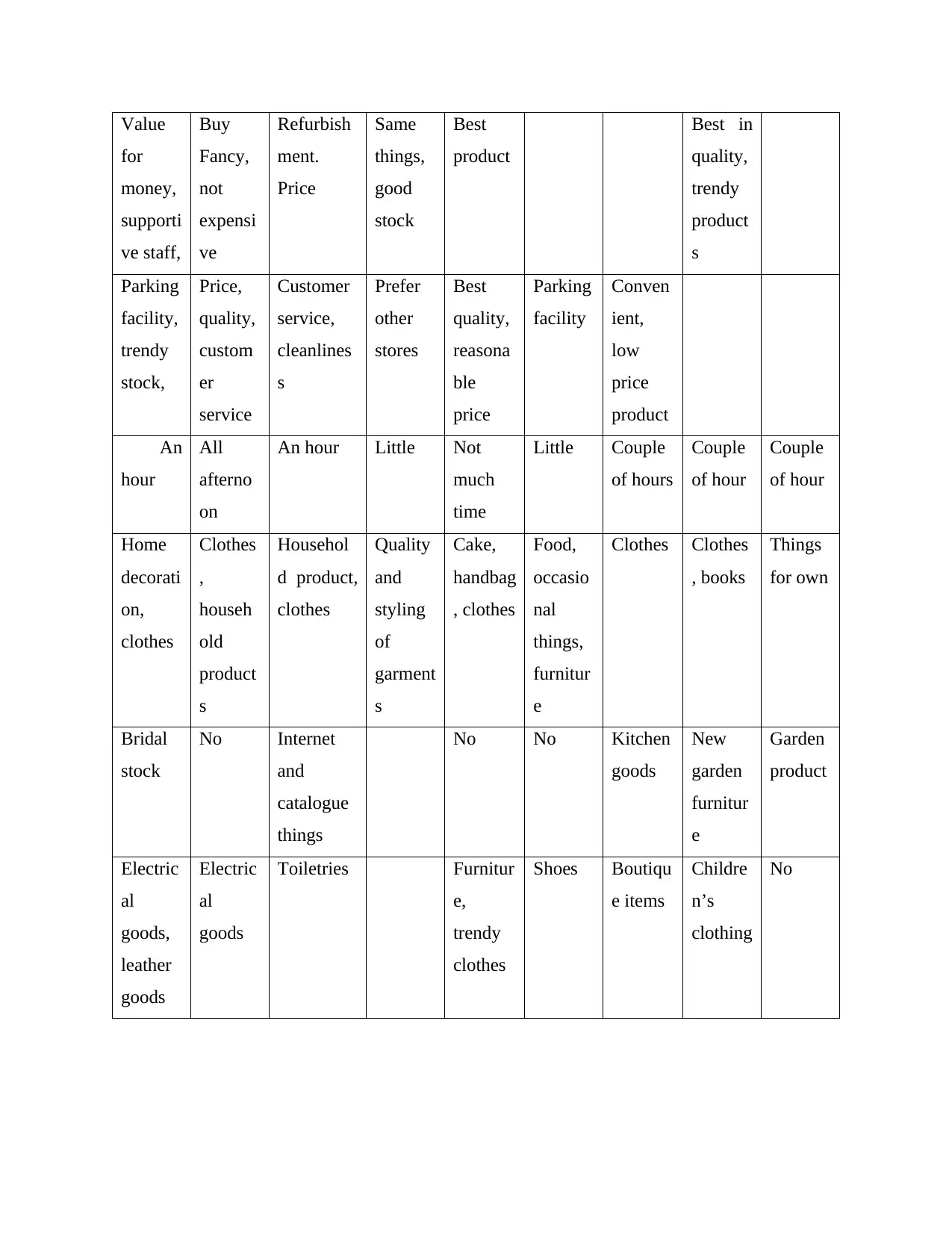
Value
for
money,
supporti
ve staff,
Buy
Fancy,
not
expensi
ve
Refurbish
ment.
Price
Same
things,
good
stock
Best
product
Best in
quality,
trendy
product
s
Parking
facility,
trendy
stock,
Price,
quality,
custom
er
service
Customer
service,
cleanlines
s
Prefer
other
stores
Best
quality,
reasona
ble
price
Parking
facility
Conven
ient,
low
price
product
An
hour
All
afterno
on
An hour Little Not
much
time
Little Couple
of hours
Couple
of hour
Couple
of hour
Home
decorati
on,
clothes
Clothes
,
househ
old
product
s
Househol
d product,
clothes
Quality
and
styling
of
garment
s
Cake,
handbag
, clothes
Food,
occasio
nal
things,
furnitur
e
Clothes Clothes
, books
Things
for own
Bridal
stock
No Internet
and
catalogue
things
No No Kitchen
goods
New
garden
furnitur
e
Garden
product
Electric
al
goods,
leather
goods
Electric
al
goods
Toiletries Furnitur
e,
trendy
clothes
Shoes Boutiqu
e items
Childre
n’s
clothing
No
for
money,
supporti
ve staff,
Buy
Fancy,
not
expensi
ve
Refurbish
ment.
Price
Same
things,
good
stock
Best
product
Best in
quality,
trendy
product
s
Parking
facility,
trendy
stock,
Price,
quality,
custom
er
service
Customer
service,
cleanlines
s
Prefer
other
stores
Best
quality,
reasona
ble
price
Parking
facility
Conven
ient,
low
price
product
An
hour
All
afterno
on
An hour Little Not
much
time
Little Couple
of hours
Couple
of hour
Couple
of hour
Home
decorati
on,
clothes
Clothes
,
househ
old
product
s
Househol
d product,
clothes
Quality
and
styling
of
garment
s
Cake,
handbag
, clothes
Food,
occasio
nal
things,
furnitur
e
Clothes Clothes
, books
Things
for own
Bridal
stock
No Internet
and
catalogue
things
No No Kitchen
goods
New
garden
furnitur
e
Garden
product
Electric
al
goods,
leather
goods
Electric
al
goods
Toiletries Furnitur
e,
trendy
clothes
Shoes Boutiqu
e items
Childre
n’s
clothing
No
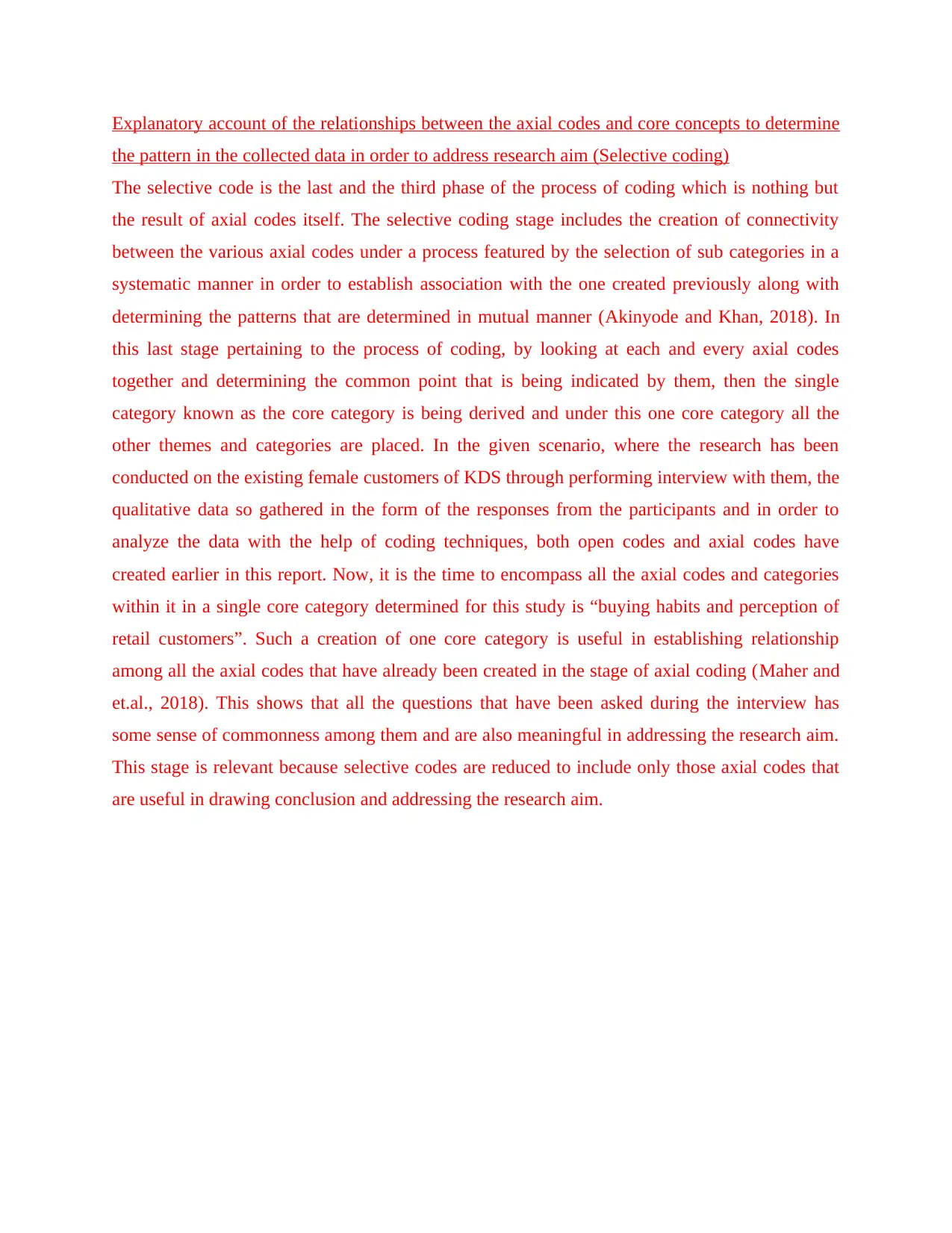
Explanatory account of the relationships between the axial codes and core concepts to determine
the pattern in the collected data in order to address research aim (Selective coding)
The selective code is the last and the third phase of the process of coding which is nothing but
the result of axial codes itself. The selective coding stage includes the creation of connectivity
between the various axial codes under a process featured by the selection of sub categories in a
systematic manner in order to establish association with the one created previously along with
determining the patterns that are determined in mutual manner (Akinyode and Khan, 2018). In
this last stage pertaining to the process of coding, by looking at each and every axial codes
together and determining the common point that is being indicated by them, then the single
category known as the core category is being derived and under this one core category all the
other themes and categories are placed. In the given scenario, where the research has been
conducted on the existing female customers of KDS through performing interview with them, the
qualitative data so gathered in the form of the responses from the participants and in order to
analyze the data with the help of coding techniques, both open codes and axial codes have
created earlier in this report. Now, it is the time to encompass all the axial codes and categories
within it in a single core category determined for this study is “buying habits and perception of
retail customers”. Such a creation of one core category is useful in establishing relationship
among all the axial codes that have already been created in the stage of axial coding (Maher and
et.al., 2018). This shows that all the questions that have been asked during the interview has
some sense of commonness among them and are also meaningful in addressing the research aim.
This stage is relevant because selective codes are reduced to include only those axial codes that
are useful in drawing conclusion and addressing the research aim.
the pattern in the collected data in order to address research aim (Selective coding)
The selective code is the last and the third phase of the process of coding which is nothing but
the result of axial codes itself. The selective coding stage includes the creation of connectivity
between the various axial codes under a process featured by the selection of sub categories in a
systematic manner in order to establish association with the one created previously along with
determining the patterns that are determined in mutual manner (Akinyode and Khan, 2018). In
this last stage pertaining to the process of coding, by looking at each and every axial codes
together and determining the common point that is being indicated by them, then the single
category known as the core category is being derived and under this one core category all the
other themes and categories are placed. In the given scenario, where the research has been
conducted on the existing female customers of KDS through performing interview with them, the
qualitative data so gathered in the form of the responses from the participants and in order to
analyze the data with the help of coding techniques, both open codes and axial codes have
created earlier in this report. Now, it is the time to encompass all the axial codes and categories
within it in a single core category determined for this study is “buying habits and perception of
retail customers”. Such a creation of one core category is useful in establishing relationship
among all the axial codes that have already been created in the stage of axial coding (Maher and
et.al., 2018). This shows that all the questions that have been asked during the interview has
some sense of commonness among them and are also meaningful in addressing the research aim.
This stage is relevant because selective codes are reduced to include only those axial codes that
are useful in drawing conclusion and addressing the research aim.
⊘ This is a preview!⊘
Do you want full access?
Subscribe today to unlock all pages.

Trusted by 1+ million students worldwide
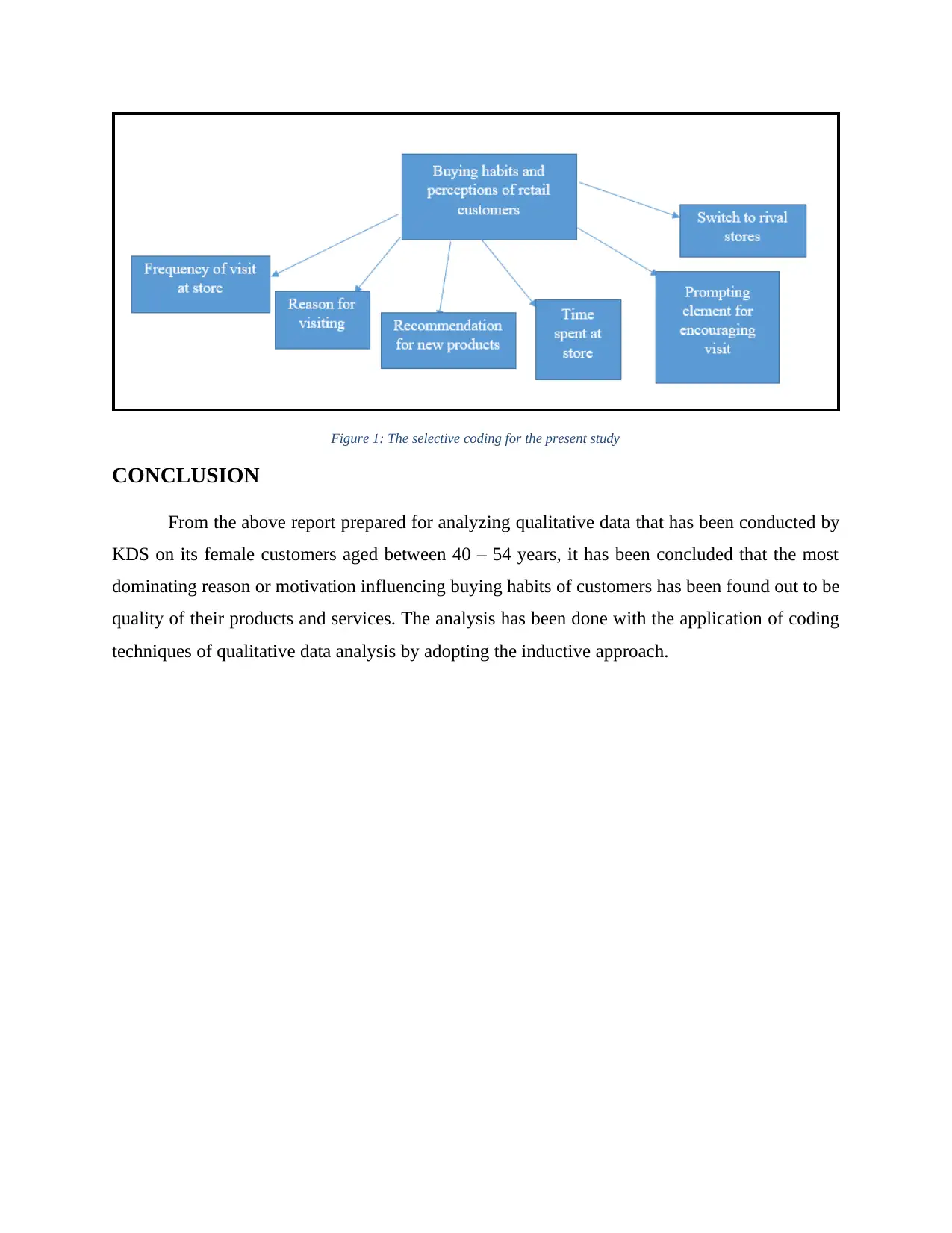
Figure 1: The selective coding for the present study
CONCLUSION
From the above report prepared for analyzing qualitative data that has been conducted by
KDS on its female customers aged between 40 – 54 years, it has been concluded that the most
dominating reason or motivation influencing buying habits of customers has been found out to be
quality of their products and services. The analysis has been done with the application of coding
techniques of qualitative data analysis by adopting the inductive approach.
CONCLUSION
From the above report prepared for analyzing qualitative data that has been conducted by
KDS on its female customers aged between 40 – 54 years, it has been concluded that the most
dominating reason or motivation influencing buying habits of customers has been found out to be
quality of their products and services. The analysis has been done with the application of coding
techniques of qualitative data analysis by adopting the inductive approach.
Paraphrase This Document
Need a fresh take? Get an instant paraphrase of this document with our AI Paraphraser
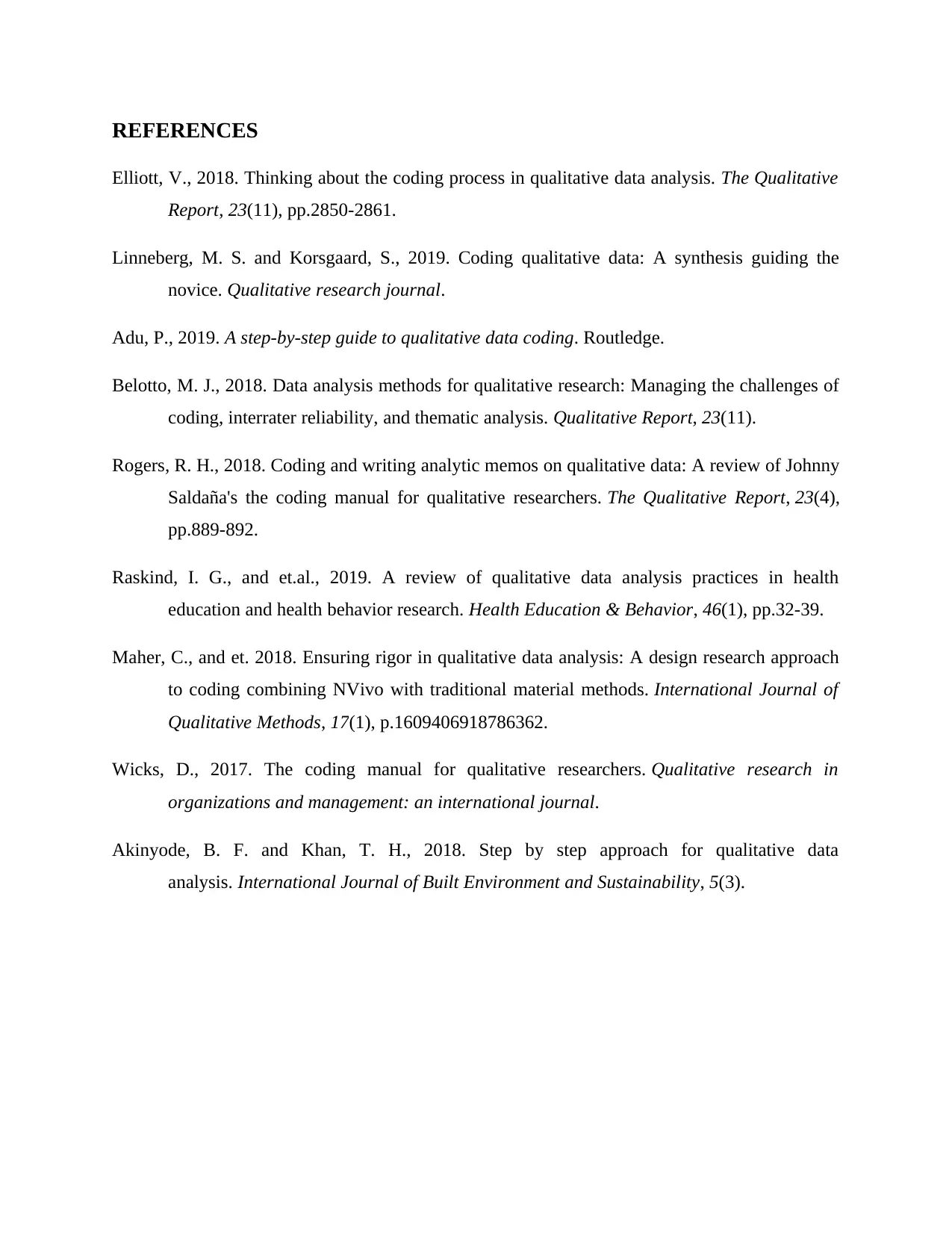
REFERENCES
Elliott, V., 2018. Thinking about the coding process in qualitative data analysis. The Qualitative
Report, 23(11), pp.2850-2861.
Linneberg, M. S. and Korsgaard, S., 2019. Coding qualitative data: A synthesis guiding the
novice. Qualitative research journal.
Adu, P., 2019. A step-by-step guide to qualitative data coding. Routledge.
Belotto, M. J., 2018. Data analysis methods for qualitative research: Managing the challenges of
coding, interrater reliability, and thematic analysis. Qualitative Report, 23(11).
Rogers, R. H., 2018. Coding and writing analytic memos on qualitative data: A review of Johnny
Saldaña's the coding manual for qualitative researchers. The Qualitative Report, 23(4),
pp.889-892.
Raskind, I. G., and et.al., 2019. A review of qualitative data analysis practices in health
education and health behavior research. Health Education & Behavior, 46(1), pp.32-39.
Maher, C., and et. 2018. Ensuring rigor in qualitative data analysis: A design research approach
to coding combining NVivo with traditional material methods. International Journal of
Qualitative Methods, 17(1), p.1609406918786362.
Wicks, D., 2017. The coding manual for qualitative researchers. Qualitative research in
organizations and management: an international journal.
Akinyode, B. F. and Khan, T. H., 2018. Step by step approach for qualitative data
analysis. International Journal of Built Environment and Sustainability, 5(3).
Elliott, V., 2018. Thinking about the coding process in qualitative data analysis. The Qualitative
Report, 23(11), pp.2850-2861.
Linneberg, M. S. and Korsgaard, S., 2019. Coding qualitative data: A synthesis guiding the
novice. Qualitative research journal.
Adu, P., 2019. A step-by-step guide to qualitative data coding. Routledge.
Belotto, M. J., 2018. Data analysis methods for qualitative research: Managing the challenges of
coding, interrater reliability, and thematic analysis. Qualitative Report, 23(11).
Rogers, R. H., 2018. Coding and writing analytic memos on qualitative data: A review of Johnny
Saldaña's the coding manual for qualitative researchers. The Qualitative Report, 23(4),
pp.889-892.
Raskind, I. G., and et.al., 2019. A review of qualitative data analysis practices in health
education and health behavior research. Health Education & Behavior, 46(1), pp.32-39.
Maher, C., and et. 2018. Ensuring rigor in qualitative data analysis: A design research approach
to coding combining NVivo with traditional material methods. International Journal of
Qualitative Methods, 17(1), p.1609406918786362.
Wicks, D., 2017. The coding manual for qualitative researchers. Qualitative research in
organizations and management: an international journal.
Akinyode, B. F. and Khan, T. H., 2018. Step by step approach for qualitative data
analysis. International Journal of Built Environment and Sustainability, 5(3).

APPENDIX
Code book
Code book
⊘ This is a preview!⊘
Do you want full access?
Subscribe today to unlock all pages.

Trusted by 1+ million students worldwide
1 out of 15
Related Documents
Your All-in-One AI-Powered Toolkit for Academic Success.
+13062052269
info@desklib.com
Available 24*7 on WhatsApp / Email
![[object Object]](/_next/static/media/star-bottom.7253800d.svg)
Unlock your academic potential
Copyright © 2020–2025 A2Z Services. All Rights Reserved. Developed and managed by ZUCOL.





